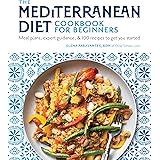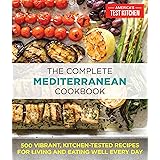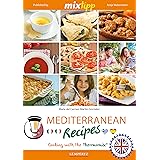Embarking on a journey to embrace the Mediterranean diet can be a truly transformative step for one’s health. As highlighted by Dr. Anna Pleet, a medical doctor with training in Italy, the cornerstone of this celebrated eating pattern lies in a selection of accessible, versatile, and nutrient-dense foods. This guide is designed to complement the valuable insights presented in the video above, delving deeper into these essential ingredients that form the foundation of a Mediterranean lifestyle. For beginners, understanding these staples is paramount to successfully integrating the diet into daily life.
The Mediterranean way of eating is not merely a diet; it is a holistic approach to health, emphasizing whole, unprocessed foods, abundant plant-based options, and healthy fats. It has been widely recognized for its profound benefits, including supporting heart health, reducing inflammation, and promoting longevity. By focusing on these core foods, individuals are empowered to create delicious, satisfying, and health-boosting meals.
1. Olive Oil and Olives: The Liquid Gold of the Mediterranean Diet
At the very top of any Mediterranean diet food list, olive oil invariably takes its place. This isn’t surprising, as olives are grown prolifically around the Mediterranean Sea, and their oil has been consumed for centuries, if not millennia, by local cultures. It is universally acknowledged as one of the healthiest fats available to us, being rich in mono and polyunsaturated fatty acids.
These particular fatty acids are extensively studied for their significant contributions to cardiovascular well-being. Furthermore, olive oil is prized for its substantial anti-inflammatory, antioxidant, and even certain anti-cancer properties. These benefits are attributed to a rich profile of phytonutrients, which are naturally occurring plant compounds that play a crucial role in overall health.
Beyond its nutritional prowess, the versatility and diverse flavor profiles of olive oil are truly remarkable. Much like wine, olive oil can be sampled to discern distinct aromatic properties, ranging from herbaceous to subtly floral notes, depending on the variety and region of origin. This allows for an enriching culinary experience, with different types of olive oil being selected to enhance various dishes.
2. Sardines: Small Fish, Big Benefits
Sardines, often found swimming in the Mediterranean Sea, are small, oily fish that represent a nutritional powerhouse. They are particularly valued for their high concentration of omega-3 fatty acids, which are essential for brain function, reducing inflammation, and maintaining heart health. These fatty acids are not produced by the body and must be obtained through diet.
The culinary applications for sardines are incredibly broad; they are effortlessly incorporated into numerous dishes. They can be added to fresh salads, enjoyed atop crackers or flatbreads for a quick snack, or even used as a unique topping on pizzas. A significant advantage of sardines is their availability in canned form, allowing them to be a shelf-stable and convenient option year-round. This makes them an excellent emergency protein and fat source, ensuring a healthy meal is always within reach even when grocery supplies run low.
3. Tomatoes: A Versatile Mediterranean Staple
Tomatoes are an undeniable cornerstone of Mediterranean cuisine, deeply embedded in the culinary traditions of countries like Italy and Spain. Their incredible versatility allows them to be enjoyed in countless ways. When in season, fresh tomatoes, available in numerous varieties from small cherry and grape tomatoes to larger Roma and heirloom types, offer an explosion of flavor.
Experiences such as finding “face-sized” tomatoes at a farmers’ market in the South of France, as Dr. Anna recounted, truly exemplify the rich, wild flavors that can be found. Raw tomatoes are perfect in a classic Mediterranean salad, often combined with cucumbers, onions, feta cheese, and parsley, dressed with a vinaigrette. The famed Caprese salad, with sliced tomatoes, fresh mozzarella, and basil, is another exquisite example of their use.
Beyond raw applications, tomatoes are a fantastic base for cooking. They are indispensable for pasta sauces, adding depth and richness, and serve equally well as a foundation for hearty soups and stews. For those living in climates with harsh winters, canned tomatoes or home-jarred tomato sauces ensure that this nutritious vegetable can be enjoyed throughout the year, preserving its flavor and nutritional value.
4. Garlic: Flavor and Wellness Combined
Garlic has been cherished for centuries across various cultures, not only for its distinctive, pungent flavor but also for its profound health benefits. It is a fundamental ingredient that adds significant aromatic dimension to a wide array of dishes. Scientific research has extensively documented garlic’s anti-inflammatory, antioxidant, and anti-cancer properties.
It is understood to be beneficial for managing a range of chronic diseases and is particularly noted for supporting healthy digestive and immune systems. The ways in which garlic can be utilized in the kitchen are virtually limitless. It is commonly minced and sautéed with vegetables, incorporated into sauces, soups, and stews, or used to garnish fish or meat, enhancing flavor without adding significant calories or sodium.
A simple yet delicious preparation method involves roasting a whole head of garlic until the cloves become soft and sweet. These can then be squeezed out and spread onto toast, offering a warm, mellow flavor. This preparation not only highlights garlic’s versatility but also its ability to transform simple ingredients into delightful dishes. Given its potent properties, garlic is a powerful addition to any health-conscious diet.
5. Garbanzo Beans (Chickpeas): A Fiber-Rich Powerhouse
Garbanzo beans, more commonly known as chickpeas, are celebrated as one of the healthiest foods on the planet and a staple in the Mediterranean diet. Their versatility is a key attribute, allowing for their inclusion in various forms and dishes. Perhaps their most famous form is hummus, a creamy spread made by blending chickpeas with olive oil, tahini (ground sesame paste), lemon juice, and often garlic or other spices.
However, chickpeas are not limited to hummus; they can be enjoyed whole in salads, alongside roasted vegetables, or even roasted on their own to create a crispy, satisfying snack. Nutritionally, chickpeas are exceptionally impressive. A single cup of chickpeas provides approximately 10 grams of fiber, which is a substantial contribution towards the recommended daily intake for adults, typically around 26 to 30 grams. Achieving nearly half of one’s daily fiber goal in a single meal underscores the significant role chickpeas play in promoting digestive health and satiety.
6. Cucumber: Refreshing Hydration and Versatility
Cucumbers are a wonderfully refreshing vegetable, often characterized by their high water content and mild flavor, making them incredibly easy to eat on their own. They are an indispensable ingredient in a multitude of salads, particularly those found in Mediterranean cultures. For instance, they are a key component of Greek-style salads, typically combined with tomatoes, red onion, and feta cheese.
Additionally, cucumbers are frequently chopped into the broader Mediterranean salad variety, which is enjoyed across numerous countries bordering the Mediterranean Sea. Known for their cooling properties, cucumbers are also a perfect addition to yogurt-based dips like tzatziki, providing a crisp counterpoint to the creamy texture. Their simplicity allows for direct consumption, such as dipping slices into hummus, baba ganoush, or other flavorful spreads, making them a healthy and accessible snack.
7. Anchovies: Pungent Flavor, Powerful Nutrients
Similar to sardines, anchovies are small, oily fish teeming with omega-3 fatty acids, making them exceptionally healthy additions to the Mediterranean diet. While their strong, distinct flavor might be a consideration for some, when paired correctly, anchovies contribute an extraordinary depth of taste to various dishes. They can be integrated into salads, placed on flatbreads, or used as a savory topping on pizzas.
In regions such as North America, anchovies are a popular ingredient in traditional Caesar salads, where their saltiness and umami elevate the dressing. Like sardines, anchovies are commonly available canned, offering a highly convenient and long-lasting pantry staple. Having a can of anchovies on hand ensures that a rich source of healthy fats and flavor can always be introduced into meals, even on short notice.
8. Greek Yogurt: Probiotic Rich and Protein Packed
While the Mediterranean diet generally de-emphasizes a high intake of animal products and dairy, Greek yogurt stands out as a notable exception due to its exceptional nutritional profile. It is particularly lauded for its abundance of probiotics, which are beneficial bacteria that contribute significantly to a healthy gut microbiome and overall digestive well-being. The positive impact of probiotics on gut health is widely researched and understood to support various bodily functions.
Furthermore, Greek yogurt is an excellent source of protein, an essential macronutrient often under-consumed in many diets. Incorporating Greek yogurt into meals is an easy and effective way to boost protein intake, contributing to satiety and muscle health. Its versatility extends beyond breakfast parfaits; Greek yogurt serves as an ideal base for savory dips, such as tzatziki sauce, or can be customized with lemon juice, garlic, and various herbs and spices to create unique flavor combinations. Its presence in the fridge offers a convenient and nutritious option for diverse culinary creations.
9. Fresh Herbs: Elevating Flavor and Health
Fresh herbs are more than just garnishes in Mediterranean cuisine; they are powerful tools for infusing dishes with rich flavors and beneficial compounds without adding extra calories or sodium. Common herbs like basil, rosemary, thyme, and oregano are frequently used, celebrated for their intense aroma and taste when fresh. They can be finely chopped into cooked dishes, or left raw and used to garnish salads, providing a burst of freshness.
The use of herbs and spices is a cornerstone of healthy cooking, enabling cooks to add significant depth and complexity to meals, moving away from reliance on sugary or overly processed sauces. Dried forms of these herbs also maintain their flavor, making them readily available for use in sauces, soups, stews, and as seasoning for fish, chicken, or other meats throughout the year. The generous inclusion of fresh herbs is characteristic of the Mediterranean diet, reflecting a commitment to natural, vibrant flavors and health-promoting ingredients.
10. Eggplant: The Versatile Vegetable
Eggplant holds a unique and highly versatile position in Mediterranean cooking, sometimes affectionately referred to as the “poor man’s steak” by Italians, highlighting its ability to take on diverse textures and flavors. Its adaptability to various cooking methods is remarkable: it can be grilled, sautéed, deep-fried, steamed, boiled, or even mashed into sauces. This makes it an incredibly flexible ingredient for any kitchen.
A classic Mediterranean dip, Baba Ganoush, perfectly showcases eggplant’s potential. This dish is prepared by roasting eggplant until tender, then blending it with roasted tomatoes or red peppers, spices, and olive oil, resulting in a rich, smoky, and utterly delicious spread. For those unfamiliar with cooking eggplant, exploring its different preparations can reveal a whole new world of culinary possibilities, making it a valuable addition to the Mediterranean diet.
11. Ancient Grains: Nourishment from History
The Mediterranean diet is deeply rooted in historical eating practices, and this is particularly evident in its embrace of ancient grains. These are grains that have been cultivated for hundreds, if not thousands, of years, predating modern agricultural modifications. Examples include emmer, einkorn, and spelt, which are distinct varieties of wheat, alongside barley, oats, farro, freekeh, and bulgur. While some names may be unfamiliar, these grains are increasingly accessible and offer a wealth of nutritional benefits.
As complex carbohydrates, ancient grains are digested slowly, providing sustained energy and contributing significantly to daily fiber intake. Many also contain a modest amount of protein, along with an impressive array of essential minerals and vitamins. Their versatility allows them to be served as a side dish, similar to rice, or integrated into vibrant grain bowls and salads. Resources like those provided by groups such as Oldways offer excellent insights into the unique qualities and health benefits of these historical whole grains.
12. Lemon: The Brightening Citrus
Lemon is the final essential food on this list, acting as a crucial element that brings brightness and dimension to countless Mediterranean dishes. The inclusion of an acidic component, such as lemon juice, has the power to “lift” and enhance the flavors of almost any culinary creation. It is a perfect garnish for seasoning vegetables, fish, and meats, providing a refreshing zest.
Furthermore, lemon juice is an excellent base for vinaigrettes, creating light and flavorful dressings for salads, or serving as a marinade to tenderize and infuse foods with its distinct aroma. Its utility, however, extends beyond savory preparations. Lemon is a star ingredient in many Mediterranean desserts, notably the Granita Siciliana, a traditional Italian frozen dessert with a strong lemon flavor. This icy, sorbet-like treat is a wonderfully refreshing option, particularly enjoyable during the heat of summer. The enduring appeal of lemon across both savory and sweet dishes underscores its indispensable role in the Mediterranean approach to eating.











